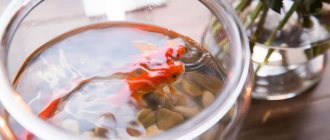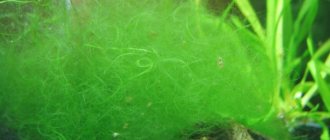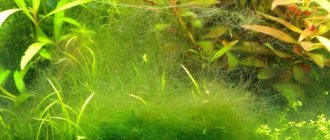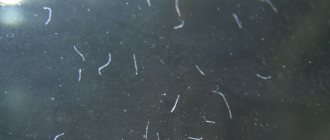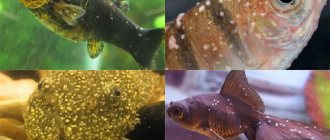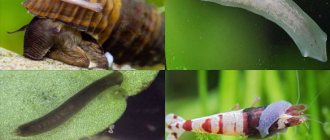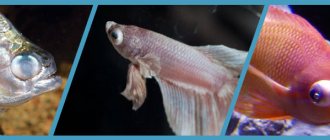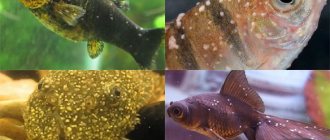Healthy aquarium fish should have bright colors, clean scales that fit tightly to the body, even fins and clear eyes. Dull coloring, loss of fin integrity, loss of scales and cloudy eyes are signs of the disease. White coating on fish in an aquarium is one of the most commonly observed symptoms characteristic of various diseases. If it is detected, you must try to establish the cause of this phenomenon as soon as possible and begin appropriate treatment in order to prevent infection and death of all fish in the aquarium.
Ichthyophthyriosis: causes and manifestations
This disease of aquarium fish is one of the most common. Its danger lies in the rapid transmission of infection. As soon as a fish or plant from an infected environment enters the aquarium, the parasite finds new victims. The causative agent of the disease is a single-celled ciliate. Most often, it lives in neglected aquariums, where the requirements for water purification, its acidity, aeration, and temperature are not sufficiently met.
A white coating in the form of small dots (also called semolina) appears on the skin, fins and even eyes within a few days after infection. The behavior of the fish changes: it often swims to the surface, gasps for air, and reluctantly accepts food. It may sink to the bottom, scratch itself on the ground or stones, or decorations. Under these conditions, one cannot expect that it will “go away on its own” under any circumstances.
If we talk about who is more susceptible to the disease, then it is impossible to single out any type. Everyone can be affected, both cold-water and tropical.
We independently remove limescale from the walls of the aquarium and glass
Experienced aquarium fish lovers know well how to clean an aquarium from limescale deposits without unnecessary costs and loss of time. But for novice aquarists, this can be a serious problem that cannot be solved without additional sources of information.
- 1 Causes of plaque
- 2 How to clean the walls of the aquarium and what products to use 2.1 Special products
- 2.2 Folk remedies
- 3 Mechanical cleaning
- 4 Personal experience
- 5 Cleaning the aquarium without draining the water
- 6 Prevention, tips and recommendations
- 7 Find out how to remove plaque from the walls of an aquarium:
Treatment and prevention measures
Medicines for the treatment of ichthyophthyriosis contain substances that kill single-celled parasites, but are safe for fish. One of these is Kostatur ().
On the first day of treatment in a general aquarium, the medicine is added according to the instructions simultaneously with cleaning the soil and partially (up to 20%) replacing the water. The same procedure is repeated throughout the week, every other day. The temperature during this period should be maintained 2-3 degrees above normal (the species composition of the inhabitants must be taken into account). Seven days are usually sufficient for a course of treatment for most fish species. The exception is some cyprinids and locarids. It is advisable for them to reduce the dose of the drug by half and double the period of fight against the disease.
You can improve the health of your pets at home with good results in a separate container, using the same scheme (calculate the dose of medication by the amount of water according to the attached instructions). It is advisable to carry out prophylaxis for all fish that come into contact with an infected individual. Without receiving food from the “hosts”, parasites in a fish-free aquarium will disappear in a few days.
Using unsuitable water
For spraying the terrarium, bathing and drinking, use only drinking water (in bottles or after cleaning with a filter). Do not use tap water for these purposes, as it is often hard and contains excessive amounts of mineral salts and impurities.
Running hard water, when it hits the shell and evaporates, leaves a whitish residue, a coating on the Achatina shell (remember the situation with a kettle, if you boil untreated tap water in it).
This plaque is not so easy to wash off. And such water is not good for the health of the snail.
But there is no need to go to the other extreme - do not use distilled water, since it is dead water and is not suitable for drinking.
The ideal option is softened and filtered water, bottled artesian water, or at least boiled water.
It is poor quality water that is the main cause of the whitish coating on the snail’s shell.
By the way, if the water is too hard, then whitish marks will also remain on the walls of the terrarium after spraying as the water evaporates. This is an additional signal that you are using poor quality water.
“White moss” is a symptom of saprolegniosis
This disease develops under unfavorable conditions: low temperature water and its high acidity. The development of the saprolegnia fungus is also accompanied by leftover food and fish injuries. It is in injured areas that the fungus hastens to settle. An area of skin or fin is populated with “white moss”, in which, upon careful examination, thin threads can be seen. They lengthen, intertwine, gathering into a lump. Later, new areas of the body are invaded and internal organs become infected.
How to treat if the fish has caught saprolegniosis? The infected individual should be placed in a separate container (jar) using water from an inhabited aquarium. Bicillin-5 is used to destroy the fungus. It is diluted in water at the rate of 500 thousand units per 100 liters. Recovery is practiced for 5-6 days. Keep the temperature elevated (up to 25-26 degrees).
Treatment with bicillin, diluted in the specified ratio, is also carried out for aquarium plants, stones, and decorations. An important point: the drug is effective only in a darkened room.
The most common problems when maintaining an aquarium
Every underwater lover in the room has had to deal with aquarium cleanliness issues at one time or another.
The most common problems.
- Cloudy water . The water loses its transparency and acquires a whitish tint. Most often this happens in a new aquarium that has just been stocked with fish. This phenomenon is temporary. The development of a mass of bacteria makes the water opaque. This continues for two to three days. With proper feeding of the fish and optimal temperature conditions, the next stage in the formation of the underwater world begins - the biological balance between single-celled organisms and more highly organized ones. The infusorial haze disappears.
- Rotting in the ground . After some time, the soil may become covered with a dark film and periodically release bubbles. Rotting occurs of organic residues that entered the soil initially or during the process of feeding the fish. To prevent this from happening, it is better to underfeed your pets than to overfeed them. An additional means of combating organic matter in the soil are snails.
- Changing the color of the water to green or brown . This happens due to the development of algae in the water: green, blue-green or brown.
- Plaque formation on the walls . The plaque can also be green or brown.
These two problems are interrelated, often have common causes, and the means to eliminate them are also the same. Plaque on the walls is the biggest nuisance in the life of an aquarium.
Green plaque on the walls: how to get rid of it?
Brown plaque is caused by the development of brown algae. The reason for its formation is the lack of light in the aquarium. As in any living body of water, in our closed underwater world there are all types of microorganisms, bacteria and algae.
Brown algae problem solved. Most often this happens due to their replacement with green algae, as they are more highly organized. The most famous from the school biology course is Euglena green. It is this algae that is the main cause of green water. The coating is formed by green algae of other species - filamentous edogonium and xenococus.
These are the most common green algae that grow on the walls of the aquarium and stones on the ground. Dealing with them is much more difficult, so we will consider all the ways.
- The main reason for the rapid development of green algae is excessive lighting . Avoid direct sunlight on the aquarium. The distance to the window must be at least 1.5 meters. Select artificial lighting lamps at a rate of 0.5 W/l for no more than 8 hours a day. With a higher pH in the aquarium, green algae also grow less rapidly.
- Regular cleaning of walls and partial water changes . Take care of your underwater world and you will avoid many problems. Cleaning the walls should be done with a soft sponge; cutting with a blade is a last resort. Scratches on the glass allow algae particles to remain and continue to multiply. Water changes should not be more than ¼ of the total volume.
- Biological cleaning method . This is the most desirable method. Many species of aquarium fish feed on algae. Almost all viviparous animals include guppies, swordtails, platies and mollies. Crucians, goldfish, veiltails, and telescopes also diversify their diet with greens. Experts say that the better aquarium plants grow, the less algae multiply. A variety of snails will be of great help in cleaning the walls and water. They eat the remains of the remaining food, some filter the water through themselves, thus feeding on unicellular algae. Ampularia love to chew algae off glass. But, as with everything, you need to observe moderation. Daphnia and cyclops can quickly clear the entire volume, but they themselves are tasty prey for fish.
- Salting the water. In this article we are looking at freshwater aquariums. Sea walls are not overgrown with green algae; they have their own problems. If acidifying the water is impossible due to the presence of certain types of fish, you can try adding salt to the water, no more than 1 g/l. Salt will retard the development of green algae in the water.
- Chemical method . Antibiotics are useful in the fight against bacteria and lower algae if the problem has gone too far and other methods do not help. You can treat the aquarium with Riboflavin, Tripaflavin, Rivanol (0.1 g per 100 l). But when these substances are used, snails and some aquarium plants with delicate green leaves suffer. Cabomba and hornwort will drop their leaves immediately after applying these medications. Streptomycin and Penicillin are less harsh. Plants and fish will not be harmed. The dose of Streptomycin used is 0.3 mg/l for 48 hours, then the water should be changed. The safest chemical for disinfecting an aquarium is 3% hydrogen peroxide. Concentration from 2 to 6 mg/l with enhanced aeration. No water change required.
Biological balance is the key to the cleanliness of your aquarium
The easiest way to achieve a clean aquarium is to organize it correctly from the very beginning. In a properly organized aquarium, biological balance is established, and the water in it can not be changed for years.
Some tips on how to start setting up an aquarium.
- The larger the volume, the easier it is to establish a biocenosis in it. Aquariums of 10 liters or more are generally considered temporary - for depositing fish during sanitary work or during spawning. An ideal aquarium is an aquarium with a volume of at least 100 liters. Only in such a water space can life organize itself.
- The population of the aquarium with fish should be at the rate of 1 medium-sized fish per 5 liters of water, preferably a little more liquid. Planting should also be taken into account. Plants absorb waste products of fish and snails from the water, saturate the water with oxygen by processing carbon dioxide during the process of photosynthesis. But in the dark, plants themselves consume oxygen, and the process of photosynthesis stops at this time. Therefore, an overabundance of plants can play a cruel joke on an inexperienced aquarist, although this is rare. An excessive number of snails can turn from a squad of cleaners into a crowd of polluters; it is necessary to thin out their population in a timely manner.
- It is advisable to purchase fish, plants and snails in specialized stores or from experienced breeders. The risk of introducing infection from a natural body of water is too great. This also applies to the contamination of an aquarium with euglena in the summer, when it intensively reproduces in ponds and lakes.
- Feeding the fish should be very moderate. Dry food should be eaten within 10-15 minutes. Preference, of course, to fresh live food. For most aquarium fish, it is not particularly difficult to fast for 3-4 days. If you are going to be away from home, you should not add food for future use.
- Illumination. The aquarium should be installed so that it is not exposed to direct sunlight, but there is sufficient illumination. A distance of 1.5 m from the window will be ideal. It is better to organize solar lighting in the morning, and a lighting duration of 8-10 hours a day is sufficient. The lack of sunlight can be compensated by artificial lighting.
Gyrodactylosis
This is another ailment that is characterized by lethargy and the appearance of a white-blue coating. At the same time, the fish compresses its fins, often touches hard surfaces with its body, and moves jerkily. The eyes become opaque, the body is covered with tiny wounds, and the fins are separated into sectors. The fish lacks air and suffers from exhaustion.
This is a signal of the presence of an infectious agent - the protozoan Gyrodactylus. The parasite is up to 0.8 mm long and clings to fish using peculiar “hooks”. It poses a particular danger to offspring.
To carry out a course of recovery, the infected individual is placed in a separate container. They use the well-known copper sulfate diluted in settled water. 15 mg per 10 liters is enough. For prevention, a common aquarium is left without the presence of fish for at least 7 days. Parasites, without “access to the body,” die. Prevention of infection of offspring with gyrodactylosis involves treating the aquarium used for spawning with regular salt (24 hours is enough).
How to treat trichodinosis
Trichodinosis in fish is caused by ciliates. Externally, the disease does not appear immediately. The fish may behave in the same way as during other infections: rubbing against stones, rising to the surface for air, or grabbing bubbles from the aerator. Over time, a white coating is observed on the scales, and mucus envelops the gills. The pet is indifferent to food and breathes frequently.
Infection is often brought into the aquarium with food (usually live), algae, or sand. It can be brought by affected individuals. Without the presence of fish, the container self-cleanses itself of parasites in a few days.
If the disease is not advanced, you can get rid of it using salt. The affected individual is placed in a quarantine container. Prepare a solution for disinfection: 10 liters of settled water will require 20 grams of ordinary salt. It is recommended to raise the temperature to the maximum (30 degrees) and start intensive aeration.
How to clean an aquarium at home
Even if you carefully monitor your offspring and the condition of your home, you still won’t be able to avoid the appearance of white deposits on the walls. You can wash the aquarium from plaque using professional and folk remedies. In difficult cases, mechanical cleaning will help.
Use of special means
This category includes cleaning compounds. They can be produced in the form of impregnated wipes, sprays or solutions. With their help, you can clean glass surfaces from plaque without harming flora and fauna. Additionally, it is worth using softeners; they allow you to wipe off traces of calcium without draining the water from the aquarium.
Effective cleansing and softening agents include:
- Tetratec . A set of wipes impregnated with substances that dissolve lime and green deposits on the walls of the aquarium.
- Aquarium Pharmaceuticals Safe and Easy . Sold as a spray. Helps clean glass and acrylic surfaces from white deposits.
- Aquayer . A softener that must be placed in the filter. Neutralizes calcium salts, reduces hardness. It is not recommended to use it for a long time; after 45 minutes you need to remove the drug from the filter.
This is just a small number of effective cleaners that you can use to scrub off lime deposits on the walls of your aquarium at home.
Before using any purchased substance, you should carefully study the instructions.
Use of folk remedies
Hydrogen peroxide and ammonia are effective means for removing plaque in an aquarium.
You can clean the aquarium with affordable compounds that you prepare yourself. Lemon and a bite are suitable for removing lime deposits on the inner surface. If you add ammonia to them, this will increase the effectiveness.
Several folk remedies for cleaning plaque on the walls of an aquarium:
- Fresh lemon juice . Can be replaced with citric acid, which is highly effective against calcium deposits. Add 20 g of juice or powder to a glass of water and mix well until completely dissolved. Rinse surfaces with lime deposits with the resulting composition. It also helps remove white deposits from plants in the aquarium.
- Vinegar . For processing it is recommended to use a 9% solution. For 200 ml add 1 tbsp. l. products and mix. Pour the liquid into a spray bottle and spray the areas with plaque. Afterwards, wipe everything thoroughly with a napkin.
- Ammonia . Dilute with water in a ratio of 1:10. Use for washing glass surfaces; for convenience, use a cloth.
- Hydrogen peroxide . Add 30 ml of product to 100 ml of water. Treat the walls of the aquarium with the prepared solution.
Many home remedies can cause skin burns, for example, vinegar, hydrogen peroxide. When working with them, it is recommended to use protective rubber gloves.
Mechanical cleaning
It is convenient to remove plaque with a special aquarium scraper.
To clean limescale and deposits from the walls of the aquarium, it is recommended to use a special plastic scraper. It is sold at any pet store. You can also use the hard area of the sponge.
It is convenient to clean hard-to-reach places using a toothbrush with stiff bristles. At the end, rinse the container thoroughly to remove any remaining dirt.
Mechanical tools can be replaced with a steam cleaner. Steam softens the plaque structure and makes it easier to remove. But it does not affect limestone.
When cleaning, it is not advisable to use metal tools. Small particles begin to rust over time, form a reddish coating and lead to scratches. All this can negatively affect the condition of the fish.
Cleaning an aquarium without draining the water
You can get rid of limescale deposits without draining the water and putting the fish out. This process is carried out in several stages:
- Remove and wash filters, internal lighting and aeration systems.
- Clean all contaminated areas using a special plastic scraper.
- Pump out 10-70% of the water. The volume depends on the frequency of maintenance.
- Replace the drained liquid with new, settled water.
After cleaning is completed, return all equipment to its place.
You can wash the aquarium without completely draining it only if you want to remove fresh deposits that have not yet become hard.
How to get rid of bone disease
The causative agent of costiasis (ichthyobodosis) is the flagellar Costia necatris. At first, the fish affected by the parasite is apathetic, rubs its body against stones and decor, and refuses to feed. As the disease worsens, the body becomes enveloped in mucus, small ulcers and grayish spots appear. Gradually they lighten, a white coating is visible. Mucous fibers clog the gills, the pet breathes with difficulty and often floats to the surface.
The infection can occur with sick individuals, live food and even sand. Having attached itself to the victim, the flagellate lives and actively reproduces. You can destroy it with the help of con (use is specified in the instructions for the product). They also fight the parasite using methylene blue.
In caring for affected pets, medicinal baths with potassium permanganate are practiced: 0.1 grams dissolved in 10 liters of settled water. Place for a limited time up to 40 minutes. Salt baths are also used: 10 l - 150-200 g. salt. Leave in this bath for 10-15 minutes. During the period of recovery, it is advisable to transfer the fish to a separate container - quarantine. The favorable temperature for this is 25 degrees.
Presence of abrasive and hard objects in the terrarium
Scuff marks may form on the snail's shell if there are hard objects in the terrarium. For example, stones. When moving, a snail can rub its shell against a hard object and scratches and whitish abrasions will form on it.
Remove hard objects from the terrarium for safety reasons as well. The snail may fall onto a hard object and break the shell.
Snail with clean healthy shell
So that the fish don't get sick
A large aquarium with clear water, lush vegetation and healthy, active fish of the most unusual colors and shapes is the result of the aquarist’s painstaking work.
What went wrong if the bright and nimble pets of the underwater world suddenly changed their behavior and even their appearance? Here are the factors that can contribute to negative phenomena in the aquarium and fish illnesses:
- the water quality does not meet the requirements for acidity, purity (presence of nitrates and other poisons), temperature level for a certain type of fish;
- insufficient aeration;
- overpopulation or incompatibility of aquarium inhabitants;
- lack (or excess) of lighting;
- incorrect (too fast) adaptation of new fish to the home aquarium;
- errors in caring for the aquarium and fish (insufficient cleaning, replacing more than 50% of the water, poor food).
Without knowledge, attention to your pets and daily care for them, it is impossible to achieve balance and harmony in the underwater world. It is necessary to eliminate negative content factors as quickly as possible, recognize the disease in time and begin treatment.
How often should aquarium glass be cleaned?
It is recommended to clean the aquarium at least twice a week. In this case, you should take into account its size and the presence of fish and decorations. Before you start cleaning the glass in the aquarium, you need to adhere to several basic rules: The health of the fish should be good. The appearance of the walls is better if it is only a light coating, and not a thorough overgrowth. Aquarium indicators - everything should be within normal limits; if something is broken, it’s time to take the time to clean it. Important! If you notice a gray-green coating over the entire area of the fish’s “dwelling,” immediately begin cleaning it. Also pay attention to the level of nitrogen in the water: if it is exceeded, change the water and treat the aquarium glass with a special solution.

